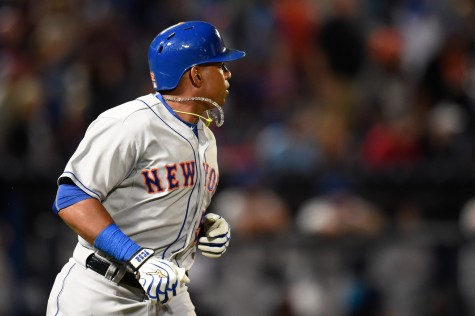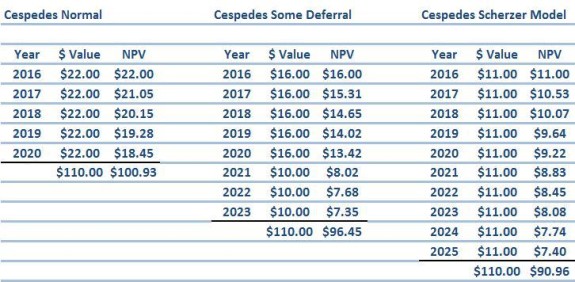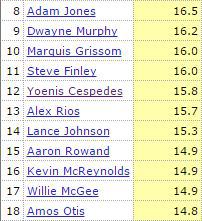
Disclaimer: This is my last post about Cespedes, I promise (probably). Also, I love Cespedes. Pointing out that he didn’t take a discount is not in any way a “knock” on him… I just want to correct a misconception.
* * *
The public perception is that by taking the Mets three year, $75 million deal, free agent slugger Yoenis Cespedes gave the Mets a “discount” or was charitable to stay. Although, yes, it is true that Cespedes is taking a smaller overall financial guarantee to stay with the Mets, it turns out that the Mets offer to Cespedes was by far the most financially lucrative for him. In turning down the Nationals deferral-laden deal, Cespedes didn’t give up much and kept the rights to all of his upside.
The Value of the Nationals Reported Offer
The Nationals offer to Cespedes was reported to have been for five years and $110 million. The catch, however, is that it contained no opt-out and significant deferrals. We can only speculate as to what “significant deferrals” means, so let’s do so below.
The Nationals recently signed Max Scherzer to a seven year, $210 million deal with deferrals. In reality, Scherzer will be paid $15 million per year from 2015 to 2028, a span of fourteen seasons. According to the MLPBA, that reduced the net present value of the Scherzer contract to $191.4 million, a reduction of $20 million from the overall dollar figure.
The MLBPA used a discount rate of a little less than 2%, but their purposes (payroll tax, etc.) are slightly different than ours, so we will use a slightly more realistic discount rate. For many years, people have used 7% as the standard rate of return in the market, and that might be the rate of return the Nationals are getting on their invested money right now. However, it is fair to assume that Cespedes’s people would have him invested in something safer, so we’ll calculate his discount rate at 4.5%.
With that in mind, let’s take a look at the NPV of Cespedes’s contracts in the following three scenarios: 1) no money deferred, 2) some money deferred, and 3) identical to Scherzer deal.

Note: any tax benefits which might come as a non-resident of DC or NY will likely not apply as Cespedes (unlike Scherzer) will not be able to “retire or Florida or Texas” because he will still be an active player when this contract expires.
Note: It was reported late last night that Peter Gammons said the NPV of the Nationals’ offer was $77 million, which is just about impossible unless the deferrals were worse than Scherzer’s or if a highly unrealistic discount rate was used.
The Value of Cespedes’s Contract with the Mets
Already, the Mets offer to Cespedes looks much more generous. There are two scenarios that can take place between Cespedes and the Mets. Either he opts-out, earning approximately $27.5 million this season, or he does not opt-out, in which case the NPV of the contract offered to him is around $72 million (remember, this deal is also front-loaded and only extends for three years).
The worst-case for Cespedes is that he performs poorly in 2016 and does not opt-out (the idea being that if he is good, he will opt-out in favor of a huge contract) so we’ll compare the Nationals deal to this scenario.
Note: It was reported that the Nationals deal may also have included an opt-out. In either case, the Mets deal with opt-out would have paid him more prior to the opt-out than the Nationals deal would have, so in any case, the Mets deal would be superior.
Outfielders Can Have a Big Paydays at Age 33
The year is 2018 and Yoenis Cespedes has just completed his deal with the Mets. Depending on the numbers, the Mets deal was somewhere between $15 to $25 million less lucrative than the Nationals offer, so in that sense, Cespedes is “betting on himself.” But when you break down the details, it turns out he’s making an extremely safe bet.
In this reasonable worst case scenario, Cespedes is a free agent again before the 2019 season, hitting free agency again two years earlier and two years younger than he would have with the Nationals. Cespedes will only be 33 years old at that point, an age where players can still receive lucrative multi-year deals.
Here are some “outfielders” who hit free agency at age 32+ over the last three seasons: Ben Zobrist ($56M), Nick Markakis ($44M),Hanley Ramirez ($88M), Jacoby Ellsbury ($153M), Shin-Soo Choo ($130M), Curtis Granderson ($60M), Carlos Beltran($45M), Michael Bourn ($48M), Josh Hamilton ($125M). This list includes some players substantially older than Cespedes, and omits a few who spend most of their time DHing (like Nelson Cruz). If you can still play, you will get paid.
Even The Reasonable Worst-Case Scenario is Better for Cespedes
What is the reasonable worst-case scenario for Cespedes? Perhaps he goes back to being a 3 WAR player in 2016 (instead of the 6.7 WAR player he was in 2015) and he has problems with injury and declines a little earlier or more drastically than someone of his unusual physical talents. Perhaps Cespedes is a shadow of himself and is only expected to produce around 2 WAR in 2019.
 There are other worst-case scenarios than this, of course. Cespedes could be hit by a meteor, or have a 99%-ile worst outcome. But Cespedes is a professional baseball player, and a good one at that, and it’s unlikely that he’ll be so much a shell of himself in three years as to be out of baseball. To the right, you’ll see a list of players since 1970 comparable to Cespedes (Between 14.8 and 16.5 WAR in their age 26-29 seasons; baserunning value > 0; OBP less than .350).
There are other worst-case scenarios than this, of course. Cespedes could be hit by a meteor, or have a 99%-ile worst outcome. But Cespedes is a professional baseball player, and a good one at that, and it’s unlikely that he’ll be so much a shell of himself in three years as to be out of baseball. To the right, you’ll see a list of players since 1970 comparable to Cespedes (Between 14.8 and 16.5 WAR in their age 26-29 seasons; baserunning value > 0; OBP less than .350).
By and large, these guys aged well. The other comparables list I made for Cespedes (OBP less than .330, Defensive WAR > 0 ) was also incredibly favorable, including only Curtis Granderson, Andre Dawson, Adam Jones, and Carl Crawford.
In any event, assuming Cespedes is a 2 WAR player in 2019 means that a reasonable contract estimate would be similar to the one Beltran signed in 2014 at age 36, or like Markakis signed in 2015 (although even this diminished version of Cespedes is better than both).
Fangraphs generally estimates that the price of a win on the free agent market ($/WAR) will increase by about 5% per year. Therefore, if it is around $8 million per win this offseason, it’ll be somewhere in the neighborhood of $9.3 million per win in 2019. If Cespedes were to take a two year contract in 2019, at current $/WAR levels at that time, and be paid like a 2 WAR player, he ought to receive somewhere in the neighborhood of two years and $36 million.
The net present value of that would be $30.9 million in today’s dollars,bringing the value of this scenario for Cespedes — the reasonable worst-case scenario — to $102.8 million over five years. This is more money than he would have received with the Nationals offer.
The Most Likely Outcome is that the Mets Contract is by Far the Best
In just about every other scenario, Cespedes does much better than if he had accepted a five year contract with the Nationals for only $110 million (with money deferred). If he’s still a good player at age 33, he may lock in one more big pay day, a la Shin-Soo Choo or Jacoby Ellsbury who both received $150+ million. Or, most likely, Cespedes will opt-out after just one season with the Mets and receive his huge payday next offseason. You can weight those outcomes any way you like, and in just about every scenario, the Mets offer to Cespedes was objectively the best one.

Let’s say in the opt-out scenario he gets a contract like Shin-Soo Choo ($150 million), in the 3-4 WAR scenario he gets a contract like Hanley Ramirez ($88 million), in the 1.5-2.5 WAR scenario he gets a contract like Nick Markakis ($44 million) and if he’s out of baseball he gets nothing. This weighted outcome is worth $125.7 million, not including the $27.5 million he’d earn from the Mets in 2016, bringing his grand total to $153.2 million, almost double of the Nationals five-year guarantee. Even if you were to weight everything pessimistically (say, for instance, that he were to only opt-out half the time and be a bad player a third of the time) his weighted outcomes would still add up to $133.3 million.
The worst thing that could happen to Cespedes is that his contract with the Mets is his last one. But in accepting the Mets deal, he’s only giving up $15 to $25 million in net present value in order to retain the right to bet on himself getting a big payday — or even a moderate one — in the future. In fact, signing a five year deal with the Nationals might have been the worst thing for a guy like Cespedes to do. Even though the Nationals were guaranteeing Cespedes $110 million, he was selling 100% of his upside and pretty much guaranteeing that he won’t get another crack at free agency in the future. And he was right, financially, to reject that deal.














